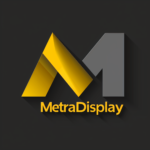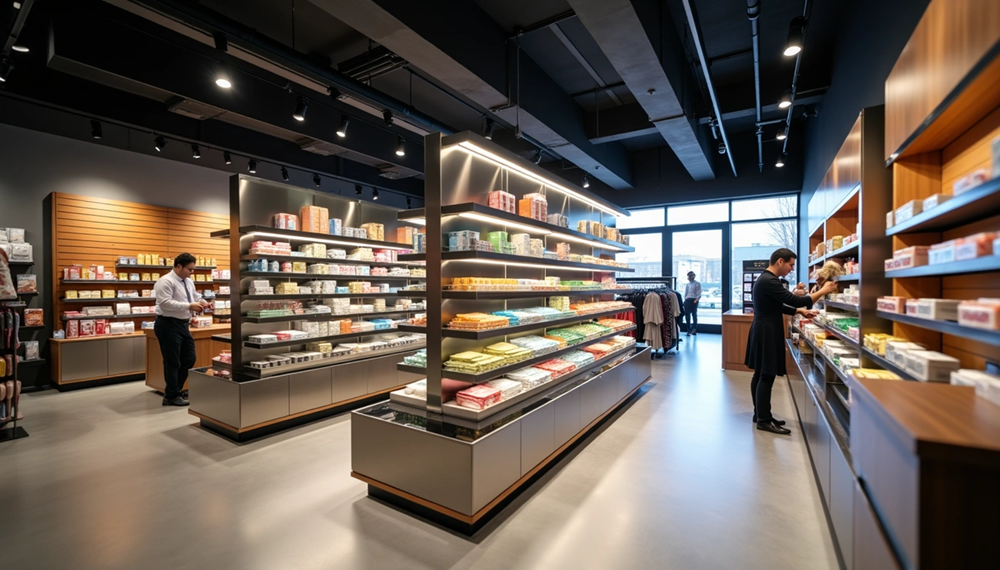
Merchandise display racks have a major influence on retail success. Research shows strategic placement alone can boost add-on sales by 30% . A well-planned store layout can increase overall sales by an astonishing 80% to 478%. One retailer switched from simple wooden shelves to customized supermarket racks and saw a 40% increase in impulse purchases. Their basket values went up by 22% in just 30 days.
The right mix of retail wall racks, merchandise displays, and retail wire display racks creates the perfect shopping environment that shapes customer behavior. A fashion retailer’s accessory sales jumped 15% after placing complementary items on adjacent racks. Proper organization using racks for retail stores goes beyond looks. A grocery chain boosted snack sales by 25% through analytical planogram implementation.
This piece explores ways to select, design, and position merchandise display racks that maximize your store’s potential. You’ll learn about material selection and future-proofing with smart technologies. These essential retail fixtures can revolutionize your space and then your profits. Marketers invest about $60 billion annually in in-store merchandising in the U.S. alone. They know that effective display strategies directly affect the bottom line.
Why Display Racks Are Critical to Retail Success
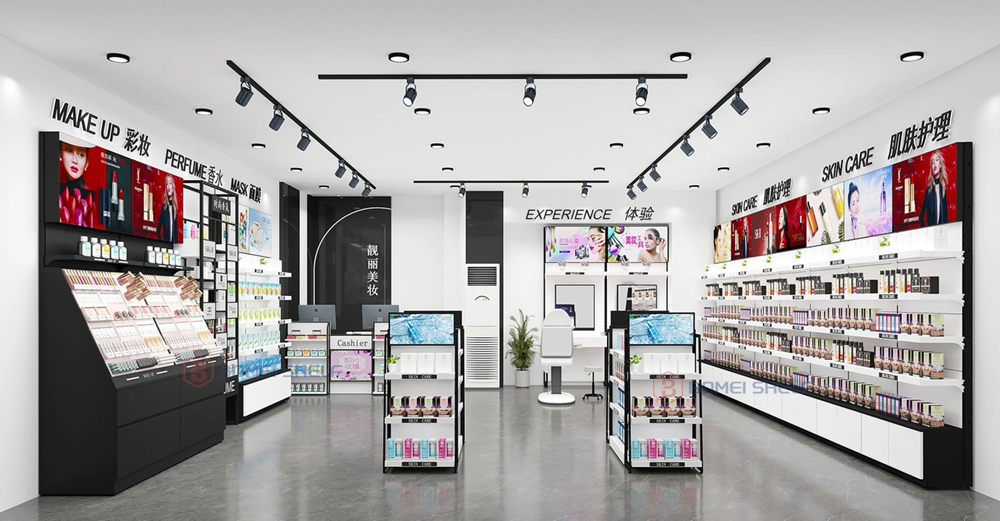
Store fixtures do more than just store products—they work as silent salespeople 24/7. Today’s retailers know these simple elements can change how customers buy and boost store performance.
Why Display Racks Are Critical to Retail Success
Drive impulse purchases and increase basket size
Studies show impulse purchases make up 40% of all retail sales. One in six customers buys a brand’s products when they see them displayed well. The numbers tell an even better story with specialized display boxes. Products in these boxes saw sales jump between 80% and 478%.
Putting display racks near checkout areas works best since 65% of impulse buys happen there. Floor displays with snacks, accessories, or gifts help add last-minute purchases that boost sales. This strategy works best with related items placed together—chips next to salsa or rolls beside cold cuts.
Guide customer flow and improve navigation
Display racks shape how customers move through your store. Stores with good traffic flow see up to 30% better conversion rates. Cluttered stores lose 15% of customer traffic compared to stores with clean layouts.
Display fixtures create natural paths for shoppers. Most customers turn right when they enter and move counterclockwise. Smart retailers put high-margin products to the right of the entrance where people notice them first.
Gondola display racks help guide shoppers and boost product interactions by 40%. These fixtures create clear paths while making products easy to see and find. Clear pathways make shoppers feel comfortable. They stay longer, explore more, and often buy more.
Maximize use of limited floor space
Wall racks and vertical displays turn space limits into advantages. Floor displays use vertical space to show many products in a small area. Small stores benefit most from this approach since every square foot must earn its keep.
Spinner rack displays offer another space-saving solution that makes browsing easier. These displays work well on floors or counters to highlight promotions without taking up much room. Tall wall shelving shows popular products at eye level without cramping the space.
Modular display systems let stores change layouts for seasons or different product sizes. Grid wall or slatwall fixtures adapt easily with shelves, hooks, and handrails while saving space. Small retailers can create attractive displays that boost sales in every inch of their store through smart fixture choices.
Key Types of Merchandise Display Racks
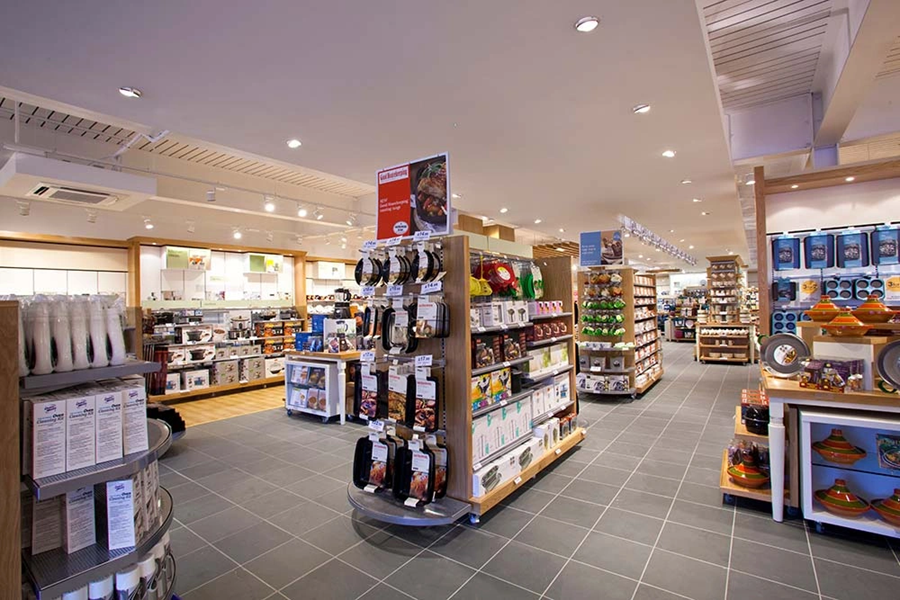
Key Types of Merchandise Display Racks
Retailers use many display solutions to create an inviting shopping environment. Each rack type plays a specific role in the merchandising strategy and helps present products in ways that connect with customers.
Gondola shelving and aisle racks
Gondola shelving serves as the foundation of most retail spaces and offers budget-friendly solutions through different setups. These units combine vertical uprights with horizontal shelves to build the main product display structure. You can find them as wall units or freestanding islands that make the best use of vertical space and floor area. Customers can reach products from both sides of the island gondolas, while end gondolas take advantage of busy spots between aisles. The base units come with a 6″ high base shelf and a vertical back panel that has slots or notches to attach shelves, peg hooks, or other accessories. These resilient fixtures can support heavy loads—some aisle displays hold up to 800 pounds.
End-cap displays for promotions
End-cap displays sit at prime spots at aisle endings and catch shoppers’ attention as they move through the main store path. These promotional tools help direct foot traffic to specific aisles and let customers explore various products. They usually have three parts—top marketing signage, middle interactive elements, and bottom merchandising area—to showcase seasonal items, limited-time offers, or featured products. Their smart placement sets promoted items apart from similar ones and helps customers choose them over other options. Stores without traditional gondola fixtures can create different end-cap experiences with wall-mounted digital displays or tabletop presentations that create natural stopping points.
Free-standing display units (FSDUs)
Free-standing display units work as independent off-shelf displays that shape how consumers buy. These units boost product visibility and brand presence at the point of purchase anywhere in the store. FSDUs work best when you launch new products or during seasonal changes. Studies show these displays catch shoppers’ attention five times more than products in regular aisles. Most FSDUs use lightweight but strong corrugated cardboard, come flat-packed for easy setup, and let you adjust shelf quantity and position. You can place them in busy areas or next to related products.
Retail wall racks and slatwall systems
Slatwall panels turn basic walls into powerful merchandising tools. These displays use horizontal slots that fit various accessories like faceouts, brackets, wire baskets, hooks, and shelving. The modular design helps retailers adapt quickly to seasonal changes or new inventory. You can put portable modular slatwall displays on countertops or set them up as floor displays, using different connectors and panel orientations. High-end versions use quality materials that resist chipping or damage. For style alone, textured 3D wall panels without slots add character to store environments.
Countertop and impulse racks
Countertop displays near checkout areas help drive impulse purchases. These small fixtures show grab-and-go items that customers can add to their purchases quickly. Research in behavioral economics shows that impulse buying happens when customers ready to buy see attractive items while waiting in line. Good countertop displays hold light items that are easy to grab, such as gum, chocolate bars, snacks, or small accessories. These fixtures work beyond grocery stores—clothing stores use special racks for impulse jewelry sales, while gas stations display car accessories and key chains.
Retail wire display racks for flexibility
Wire display racks show products clearly while taking up minimal space. Their simple design puts products in the spotlight rather than the fixture itself. These displays offer plenty of presentation space while saving valuable floor area. Many come with wheels so you can move them easily during restocking or layout changes. Wire displays excel at encouraging impulse buys near queue lines and checkout areas. You’ll find them as floor-standing or countertop versions, built tough for busy areas while offering setup options. Popular types include literature stands, rotating spinner displays, bulk bins, and adjustable slant shelving that works for everything from bottles to bakery items.
Choosing the Right Materials for Your Racks
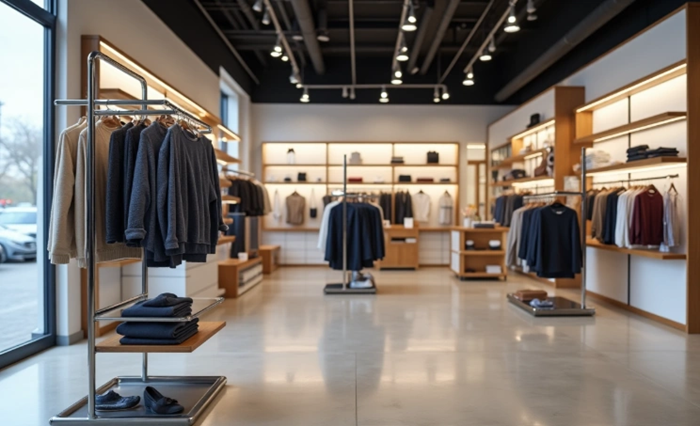
Material selection is a vital factor that determines your retail display investment. The right choice affects durability, aesthetic appeal, and ultimately impacts your bottom line.
Metal vs. wood vs. acrylic: pros and cons
Metal display racks give you superior strength and durability, which makes them perfect for heavy merchandise. These fixtures come with powder coating that fights off corrosion while giving a contemporary, industrial feel. Steel and aluminum options create sleek, sturdy permanent displays that work great with other materials. Metal racks need more money upfront, but their longer lifespan (15+ years compared to wood’s 5-8 years) gives you better value in the long run.
Wooden display racks bring warmth and authenticity that strikes a chord with eco-conscious consumers You can get them in natural hardwoods or engineered options like MDF, and these fixtures shine in boutiques and premium retail spaces. But they can get damaged by moisture and need more frequent upkeep.
Acrylic displays—also called plexiglass—give you crystal-clear transparency without breaking like glass. This adaptable material bends into curved shapes when heated, making it ideal for cosmetic countertop displays. Acrylic is 17 times more impact-resistant than glass, but it scratches easily and costs more than simple materials.
Durability and maintenance needs
Each material needs its own care routine. Metal racks need regular checks of connecting parts and rust treatment with the right inhibitors. They’re easy to clean in busy environments—just wipe them down with mild detergent and a soft cloth, then dry really well to stop rust.
Wooden fixtures work best with gentle cleaners made specifically for wood surfaces. Regular polishing and protective coatings help stop warping or cracking, especially when you have high humidity or direct sunlight.
Acrylic displays need gentle cleaning. Use microfiber cloths with mild, non-alcohol-based solutions to keep them scratch and cloud-free. Adding some acrylic-safe polish now and then cuts down on static and keeps them looking good.
Eco-friendly and recyclable options
Eco-friendly retail fixtures help brands keep their environmental promises while drawing in green-minded shoppers. Metal options like aluminum and steel stand out because they’re highly recyclable—aluminum shines here with its amazing strength-to-weight ratio and natural rust resistance.
Wooden displays can use FSC-certified materials to ensure responsible forest management. Bamboo offers another green choice, as it breaks down naturally and stays remarkably strong.
Modern eco-friendly display materials cost the same or less than standard options. Many green displays come apart easily for recycling at the end of their life, creating truly circular solutions. Smart material choices help cut your store’s carbon footprint while meeting important corporate sustainability goals.
Design Principles That Boost Sales
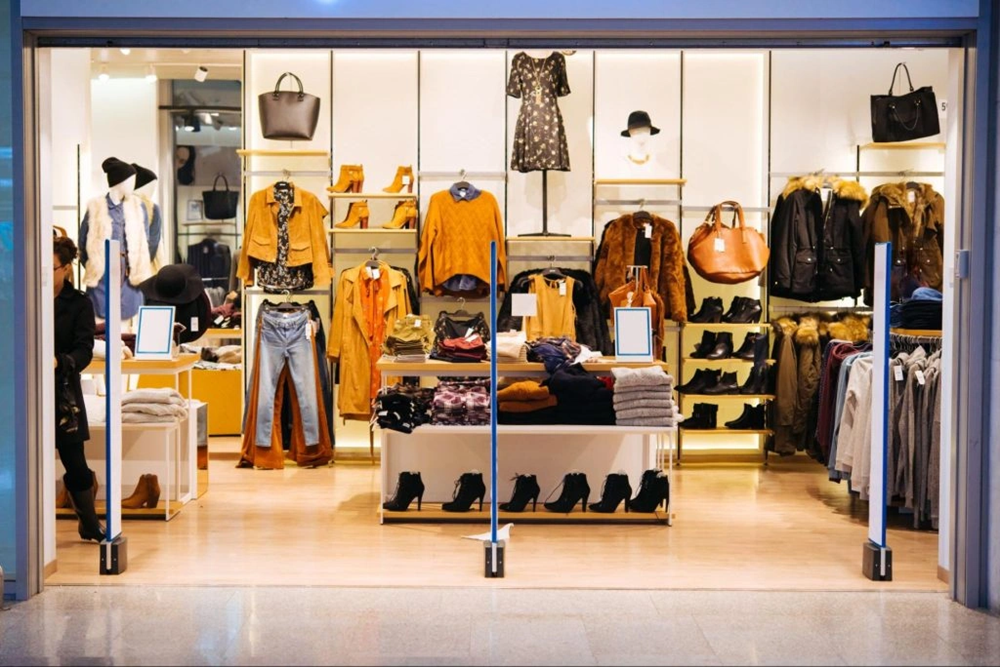
Smart placement strategies can turn regular merchandise display racks into powerful sales tools. Retailers who understand these basic design principles can make the most of their fixture investments.
Eye-level placement and sight-line strategy
Successful retailers follow the “eye level is buy level” principle. They place their high-margin products between 1.2-1.5 meters height where adults naturally look. Products in this prime spot get a lot more attention than those placed elsewhere. Research shows that shoppers make buying decisions in less than eight seconds and scan shelves from left to right. A coffee manufacturer found that shelf four had 23% greater sales potential compared to nearby shelves three or five, even though all were around eye level.
Color, lighting, and signage integration
Lighting plays a crucial role in how customers perceive and behave. Well-lit stores boost impulse purchases. Stores with softer lighting saw a 19% sales increase compared to those with harsher illumination. Signs work best when placed at eye level in high-traffic areas where shoppers naturally pause, such as endcaps and checkout lines. The content should be clear, high-contrast, and easy to read from a distance. Promotional content should match its location—snack promotions work best near snack aisles.
Modular and adjustable features for flexibility
Modular display systems let retailers change configurations easily for seasonal updates or different product sizes. These flexible solutions help stores quickly update displays for holidays, new collections, or clearance events without starting over. Systems with adjustable shelves, hooks, and accessories can handle different product sizes and create dynamic presentations that keep customers interested.
Branding with logos, QR codes, and digital elements
QR codes make displays interactive marketing tools that blend physical products with digital content. Customers can use these codes to see more product information, videos, or special offers on their smartphones. Custom-branded displays with QR codes that link to menus, websites, or social media create a continuous connection between in-store and online experiences. Shelves with digital screens can show product demos, tutorials, or customer reviews and provide great information right where customers make decisions.
Future-Proofing Your Display Strategy

Retail stores now focus on intelligent display solutions that look ahead to future needs and reduce environmental effects, moving past traditional merchandise presentation.
Smart shelves and IoT integration
Retailers increasingly use Internet of Things (IoT) technology to turn regular display racks into valuable data collection points. Smart shelves with weight sensors detect product removal automatically and notify staff about restocking needs. These systems create IoT networks that send live inventory data to cloud platforms. RFID-enabled fixtures track products with high accuracy. This helps prevent stock shortages and supports services like buy-online-pickup-in-store.
Data-driven merchandising and AI layouts
AI has changed how retailers arrange their display racks. Systems powered by AI study customer movement through in-store sensors. They create heatmaps showing popular areas and spots that need improvement. Retailers use this information to place profitable items where customers notice them most. AI also groups shoppers by their demographics and priorities to create custom store layouts. This informed approach boosts sales in each square foot by placing products better and managing customer flow.
Sustainable materials and circular design
Modern retailers welcome circular design principles. They create display racks specifically for reuse, remanufacturing, or recycling. The design uses modular parts that staff can rearrange as needed. Sustainable materials such as reclaimed wood, recycled metals, and biodegradable options reduce environmental effects substantially. Display fixtures will soon feature 3D-printed parts that create less waste. Smart materials will add functionality while staying environmentally responsible.
Conclusion
Display racks work as a silent salesforce that affects retail performance a lot. Smart rack selection, strategic placement, and the right materials work together to create shopping spaces that boost impulse purchases and revenue. Store owners who apply these principles see amazing results. Their add-on sales jump by 30%, and their stores perform much better overall.
A well-laid-out retail space helps customers move through merchandise while making the most of limited floor space. Smart retailers see display racks as key investments, not just storage solutions. They choose between metal, wood, or acrylic based on their brand look, product weight, and upkeep needs.
Products placed at eye level with proper lighting turn basic displays into sales machines. Modular systems give stores the flexibility they need for seasonal changes and inventory updates.
Forward-thinking retailers are moving past traditional displays. IoT-enabled shelves, analytical insights, and green materials show the future of retail display technology. These new tools improve customer experiences and help stores run better.
Display racks shape how customers see products and move through stores. Retailers who become skilled at visual merchandising create spaces where products almost sell themselves. This turns browsers into loyal customers and makes their profits grow.
Key Takeaways
Strategic merchandise display racks are proven revenue drivers that can transform your retail performance through smart placement and design choices.
• Strategic placement drives impulse sales: Eye-level positioning and checkout area displays can increase impulse purchases by up to 40% and boost overall sales by 80-478%.
• Choose materials based on longevity: Metal racks offer 15+ year lifespans versus wood’s 5-8 years, making them more cost-effective despite higher upfront costs.
• Modular systems maximize flexibility: Adjustable displays allow quick seasonal changes and product reconfigurations without complete overhauls, optimizing space usage.
• Smart technology enhances performance: IoT-enabled shelves with sensors provide real-time inventory data and customer insights for data-driven merchandising decisions.
• Sustainable options reduce costs: Eco-friendly materials like recycled metals and FSC-certified wood often cost the same or less than traditional alternatives while appealing to conscious consumers.
The right combination of display rack types, materials, and placement strategies creates shopping environments where products sell themselves, turning browsers into buyers and significantly improving your store’s bottom line.
FAQs
Q1. How do merchandise display racks impact retail sales? Merchandise display racks can significantly boost retail sales by driving impulse purchases, guiding customer flow, and maximizing limited floor space. Strategic placement of racks can increase add-on sales by up to 30% and overall sales by 80% to 478%.
Q2. What are the key types of display racks for retail stores? The main types of display racks include gondola shelving, end-cap displays, free-standing display units (FSDUs), retail wall racks, countertop displays, and wire display racks. Each serves a specific purpose in showcasing products and enhancing the shopping experience.
Q3. How do I choose the right material for my store’s display racks? Consider factors like durability, esthetics, and maintenance needs when selecting materials. Metal racks offer longevity, wood provides warmth, and acrylic offers transparency. Also, factor in your store’s style, product weight, and environmental goals when making your choice.
Q4. What design principles can help boost sales through display racks? Key design principles include placing high-margin products at eye level, integrating appropriate lighting and signage, using modular features for flexibility, and incorporating branding elements like logos and QR codes. These strategies can significantly impact customer engagement and purchasing decisions.
Q5. How can I future-proof my store’s display strategy? To future-proof your display strategy, consider incorporating smart shelves with IoT integration, implementing data-driven merchandising and AI-powered layouts, and using sustainable materials with circular design principles. These innovations can provide valuable insights and enhance both customer experience and operational efficiency.
